
Original Link: https://www.anandtech.com/show/2348
Cell Shock, Corsair, and Kingston Introduce Ultra Speed DDR3
by Wesley Fink on October 11, 2007 10:00 PM EST- Posted in
- Memory
We're still working on providing detailed results, but one of the interesting aspects of the new Intel X38 chipset is that memory performance improves with X38 - but only with DDR3 memory. Improvements over P35 range from 3 to 5% with DDR3, but there are no real improvements in DDR2 performance compared to P35. It should be clear to enthusiasts at this point that DDR3 appears to offer more potential for high performance than DDR2. This is certainly borne out by the dramatic memory speed increases that have been achieved with DDR3 so quickly after introduction.
There are still early issues with X38 and it will take a while for the market to sort these out, but we do expect BIOS updates and potentially hardware revisions to fix the major issues in the near future. When that happens X38 will fill the position of top performer in the Intel chipset lineup, and DDR3 memory will be the memory of choice for best performance. Looking toward that end, what DDR3 memory is best for X38 and P35 based DDR3 motherboards?
Memory based on the exciting new Micron Z9 memory chips for DDR3 first appeared a few days after the Intel P35 launch in late July. We took a look at these early high-speed DDR3 in Super Talent and TEAM: DDR3-1600 is Here! The Super Talent memory was very memorable in that review as it was the first memory product to ever reach a stable DDR3-2000 speed. OCZ followed with a refinement of the early Micron products and introduced their own higher speed DDR3-1800 a couple of weeks later, which we reviewed in OCZ Introduces DDR3-1800. OCZ extended the performance even further with stable DDR3-2040 performance and the even more remarkable DDR3-1900 at 7-7-7 timings.
It was very clear from these early products that DDR3 was well on its way to becoming the performance memory of choice, and Micron had once again succeeded in producing some of the best high-performance DDR3 chips available to the market. It has taken a couple of months for early issues to sort out and for production of the Micron Z9 chips to reach supply levels. Micron DDR3 chips are finally here in quantity, as should be evident in the new high speed memory kits from Cell Shock, Corsair, and Kingston.
As explained in the past, all memory makers buy raw memory chips available in the open market. They then rate or "bin" the chips to create one or more speed grades from a single chip type. Memory chips are then surface-mounted on generic or proprietary circuit boards with SPD (Serial Presence Detect) chips programmed with generic code or custom SPD programming done by the DIMM maker. This is why the introduction of fast new chips like the Micron Z9 often circulates rapidly through the enthusiast memory market as each manufacturer tries to introduce products based on the new chips with tweaks that outdo the competition.
Some memory makers do not like to talk about the chips used in their DIMMs, as they consider that information proprietary, but this secrecy does not normally last very long. The enthusiast memory market quickly migrates to the best performing chips and you will see the same memory chips used in many top memory kits. However, this does not mean the memory you buy from Super Talent, for example, is exactly the same as memory based on the same chips that you buy from Corsair. Companies pride themselves on the sophistication of their speed-grading technology, their design and/or sourcing of PCBs, and their skill at programming the SPD. Those skills do lead to performance differences among brands - some large and some small.
Despite the real differences in memory performance from different memory makers, memory using the same memory chips tends to cluster in test results. You can usually see a clear pattern of performance from a particular memory chip that tips you off to which memory chip is used in different memory kits.
One of the more interesting results in our tests of the Super Talent DDR3-1600 and OCZ DDR3-1800 was that both memories managed to overclock to DDR3-2000, which is the highest performance we have ever measured for system memory. This memory speed is almost double the top speed for DDR2 and establishes DDR3 as the memory of choice where maximum performance is the main concern. The OCZ RAM, which had a couple of more weeks to refine the binning and SPD, reached slightly further to DDR3-2040 with complete stability.
Will these new DDR3-1800 parts also reach DDR3-2000? With a couple of months more time for refinement is it possible they can do even better than the great results we have already seen with DDR3? Are the performance results for DDR3 on the X38 and P35 so compelling they move the check box to DDR3 despite the price premium that still exists for DDR3? Our review today will help to answer these questions.
The Contenders
In addition to the Super Talent and OCZ offerings, three new high-profile DDR3-1800 kits have been introduced in the last few weeks. Cell Shock is a new name from Germany, and they have quickly become the new darling of the extreme enthusiast. Corsair is very well known as an enthusiast memory manufacturer and introduced their DDR3-1800 shortly after we reviewed the OCZ memory. Kingston is the world's largest memory manufacturer and has just introduced their DDR3-1800 (and DDR3-1625) memory kits.
Cell Shock
Cell Shock will likely be a new name for most of our readers. The company is a new division of MSC Vertriebs GmbH in Germany. MSC has around 1000 employees and several production facilities in Germany, Scotland, and Malta. It was established by the current managing director in 1982 and grew from a very small company to an international player in the distribution of semiconductors and the manufacture of electronic applications. Today MSC mainly serves industrial clients in Europe. The customer base includes partners in medical, IT, energy, automotive, and other sectors. MSC Vertriebs GmbH is privately held by the owner who is acting as managing director.
MSC was already a partner with major manufacturers of semiconductors like Samsung, Micron, Infineon, etc., which made the move to the retail memory market a natural extension of the MSC product line. Due to the expertise MSC had gained in developing and producing memory modules for the industrial market, the company decided to establish the Cell Shock brand. The new brand is targeted at the enthusiast market. More information on Cell Shock can be found at the Cell Shock website.
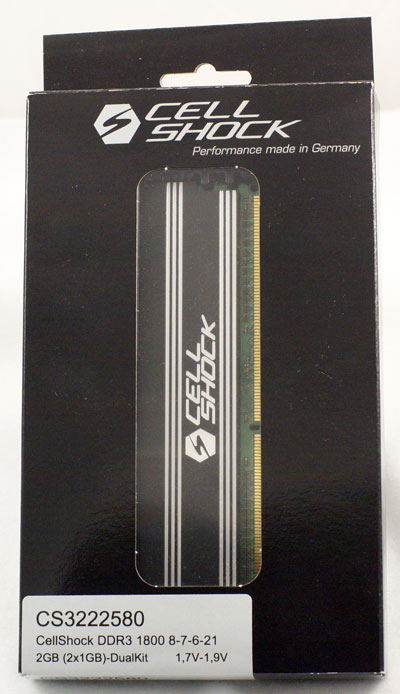
Cell Shock's packaging for the DDR3-1800 DIMM kit mirrors the black and silver theme of the DIMMs. There is very little info on the glossy black folding carton, but the info that is there is in six languages. The international flavor of this German memory is immediately apparent.
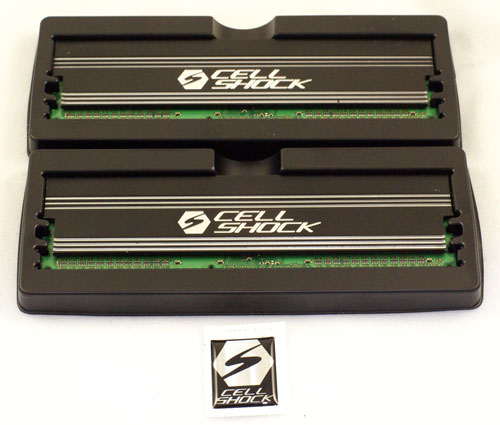
The DIMMs themselves are shrouded in heavy black and silver heatsinks that appear to be cast aluminum. The memory is attractive, with raised logos, and the heatsinks are also very heavy as heatsinks go. Cell Shock rates the memory at DDR3-1800 at 1.7V to 1.9V. They do not specify maximum voltage, but other Micron Z9-based memory has topped out at 2.1V to 2.2V with supplemental air cooling.
| Cell Shock DDR3-1800 (PC3-14400) Memory Specifications |
|
| Configuration | 2 GB Kit (2x1GB) |
| Rated Timings | 8-7-6-21 at DDR3-1800 |
| Rated Voltage | 1.7-1.9V (Standard 1.5V) |
| Module Info | Micron chips, unbuffered, non-ECC |
| Warranty | 5 Years |
The only configuration for DDR3-1800 is a 2GB (2x1GB) kit. Cell Shock also markets Micron memory chips in a DDR3-1600 2GB kit rated at 7-6-6-18 timings. Cell Shock provides a 5-year warranty on the DDR3-1800 memory, and they tell us it is not a Lifetime Warranty only because legal counsel advises a Lifetime Warranty is not possible in the EU.
Corsair
Corsair hardly requires an introduction, as it is probably the most recognized brand of enthusiast memory in the world. Corsair has been an innovator in the enthusiast memory market for many years. Corsair often partners with motherboard manufacturers, Intel, and AMD in the launches of new chipsets and boards. As a result every major reviewer is very familiar with Corsair products.
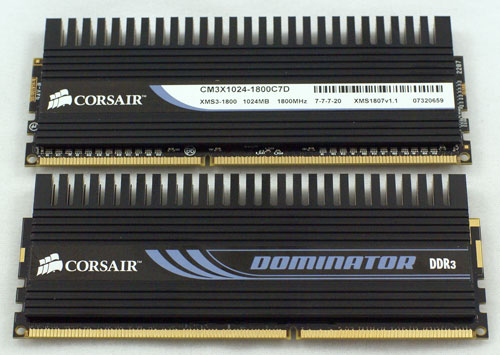
The Corsair DDR3-1800 comes in the familiar folding clamshell package. The DIMMs are typical of the Corsair DHX Dominator series. DHX, or dual-path cooling, is a proprietary Corsair feature to improve cooling. It is described in detail in an earlier review of Corsair Dominator memory if you want to know more about it. Basically the two sets of fins cool both the PCB and the memory chips separately to theoretically improve cooling.
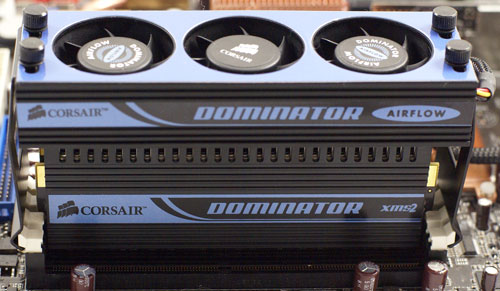
Corsair also provided a Dominator memory cooler with the pair of DIMMs. This effective memory topper helps keep you memory cool and it is available separately for those who want to add it to their system. It works well with any DDR3/DDR2/DDR memory. We use the Dominator fan or the CoolIT RAM Fan in all our memory tests.
| Corsair DDR3-1800 (TWIN3X2048-1800C7DF G) Memory Specifications |
|
| Configuration | 2 GB Kit (2x1GB) |
| Rated Timings | 7-7-7-20 at DDR3-1800 |
| Rated Voltage | 2.0V (Standard 1.5V) |
| Module Info | Micron chips, Unbuffered, non-ECC |
| Warranty | Lifetime |
The Dominator DDR3-1800 is offered in a 2GB kit or in the same 2GB configuration designed to support the Intel Extreme Memory Profiles (XMP).
Kingston
Kingston is the world's largest memory manufacturer. As a result you will find Kingston's products available at almost every computer retailer. Headquartered in Fountain Valley, California, Kingston has grown from its beginnings with a single product in 1987 to $3.4 Billion in sales last year and a catalog of over 2000 memory products. Kingston is by far the world's largest independent memory manufacturer, and it is more than three times larger than the closest competitor.
Everyone knows Kingston makes computer memory, but not everyone knows that Kingston is also a manufacturer of memory for the computer enthusiast. In the high-end memory market Kingston seems to always provide competitive products in their HyperX line, and they are large enough to often be first to market with new memory technology. The recent introduction of the PC3-14400 (DDR3-1800) is just another example of Kingston's aggressive move into the high-end memory space.
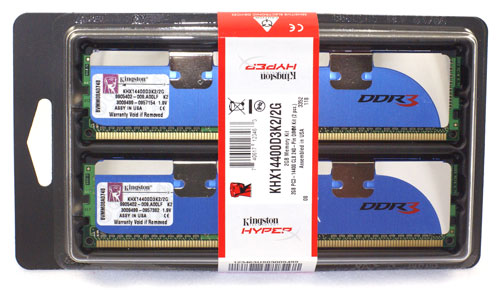
Kingston continues to use rather conservative packaging for their memory. Competitors have moved to flashier presentations of their product, but the Kingston packaging is the same whether the product is value RAM or high-end HyperX.
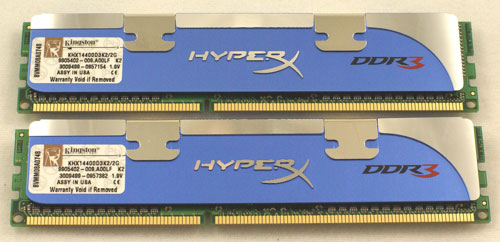
Fortunately Kingston has been paying much more attention recently to the appearance of the DIMM itself. While the DDR3-1800 still sports the characteristic sky blue color that says HyperX, this is certainly the flashiest HyperX DIMM we've ever seen. The mirror trim, sky blue, and heavy cast heatsink are truly unique and certainly stand out. We like the new HyperX appearance; it almost says something exciting is going on here, and in this case it is.
| Kingston KHX14400D3K2/2G (DDR3-1800 CAS 8) Memory Specifications |
|
| Configuration | 2 GB Kit (2x1GB) |
| Rated Timings | 8-8-8-24 at DDR3-1800 |
| Rated Voltage | 1.9V (Standard 1.5V) |
| Module Info | Micron chips, Unbuffered, non-ECC |
| Warranty | Lifetime |
Kingston also announced their KHX13000D3LL (DDR3-1625 CAS7) at the same time. We also took a look the low-latency 7-7-7 kit in our testing, but we did not report results separately. The reason for this:
In every test result the Kingston DDR3-1800 and DDR3-1625 performed exactly the same! They achieved the same overclock and timings/voltage in every test performed. Therefore you can consider all test results to apply equally to KHX14400D3K2/2G and KHX13000D3LLK2/2G. The two memories have an MSRP of around $450 for the 2GB kit. They are also priced within $3 to $5 of each other so you can select either Kingston memory based on best price.
It should be pointed out that Kingston, like other enthusiast memory makers, promises you the performance will be at least as good as rated. It may be much better, and usually is in the Micron Z9-based memory tested here, but higher performance is not guaranteed. The rated "guaranteed" speed may be an important factor to you. The Kingston DDR3-1800 is rated at DDR3-1800 at 8-8-8-24 at 1.9V, and the DDR3-1625LL is rated at DDR3-1625 at 7-7-7-20 at 1.9V.
Memory Test Configuration
In the OCZ DDR3-1800 review we launched a new memory test methodology that used a standard 3.0GHz test speed driven by a processor that can deliver multipliers to at least 9X and FSB speeds to 550+. This allows DDR3-800, DDR3-1066, and DDR3-1333 to be tested at 3.0GHz at 9x333 settings. DDR3-1600 and DDR3-2000 can be tested at 3.0GHz at 6x500 (assuming we can reach the requisite FSB).
The requirements for a 9x or higher multiplier combined with the ability to run with stability at a 550+ FSB proved more difficult than it appeared. A very early Intel X6800 had unlocked multipliers but would not even boot above about 450 FSB. A very recent Q6600 met the 9X requirement but topped out in FSB at about 470 stable. Tests by other AnandTech editors confirmed that most quad-core processors have a difficult time operating at 500 FSB, let alone the higher 550 requirements for overclocks above DDR3-2000. We finally located a recent E6600 that could do both the 9X multiplier and the 550 FSB requirements. This became our new processor for the memory test bed. Other components remained the same as the earlier DDR3 test bed.
It should be pointed out that the new test bed does use the same processor speed at all tested CPU speeds, but that different FSB speeds are used at low and high memory timings. Testing at the same processor speed does allow a better comparison of isolated memory performance, but it is not an exact apples-to-apples comparison. The variation in FSB speed at the same processor speed does affect the performance of the memory at the higher FSB speeds. This varies from negligible in some tests to measurable in other benchmarks. For more information on the impact of FSB speed on performance you can refer to Intel P35 Memory Performance: A Closer Look.
A true apples-to-apples comparison of memory performance will only be possible when the additional ratios of 1600 and 2000 are available in BIOS at a base 1333 FSB speed. While not perfect, the comparison of all memory speeds at 3.0GHz processor speed is much closer to our testing ideal than the previous test methodology.
| Memory Performance Test Configuration | |
| Processor | Intel Core 2 Duo E6600 (2.40GHz, 9x266, 4MB Unified Cache) 9x333 - 3.0 GHz 6x500 - 3.0 GHz |
| RAM | Cell Shock DDR3-1800 (2GB kit - 2x1GB, DDR3-1800 8-7-6) Corsair TWIN3X2048-1800C7DF G (2GB kit - 2x1GB, DDR3-1800 7-7-7) Kingston KHX14400D3K2/2G (2GB kit - 2x1GB, DDR3-1800 8-8-8) OCZ PC3-14400 Platinum (2GB kit - 2x1GB, DDR3-1800 8-8-8) Super Talent W1600UX2G7 (2GB kit - 2x1GB, DDR3-1600 7-7-7) Team TXD31924M1600HC9 (2GB kit - 2x1GB, DDR3-1600 9-9-9) Kingston KHX11000D3LLK2 (2GB kit - 2x1GB, DDR3-1333 7-7-7) Corsair CM3X1024-1066C7 (2GB Kit - 2x1GB- DDR3-1066 7-7-7) Corsair Dominator CM2X1024-8888C4 (2GB Kit - 2x1GB - DDR2-1250 5-5-5) |
| Hard Drive(s) | Samsung 250GB SATA2 enabled (8MB Buffer) |
| System Platform Drivers | Intel - 8.3.0.1013 |
| Video Card: | Leadtek WinFast 7950GT 256MB |
| Video Drivers: | NVIDIA 93.71 |
| CPU Cooling: | Intel Retail HSF |
| Power Supply: | Corsair HX620W |
| Motherboards: | ASUS P5K3 Deluxe (Intel P35 DDR3) ASUS P5K Deluxe (Intel P35 DDR2) ASUS P5B Deluxe (Intel P965 DDR2) |
| BIOS Revision: | 0604 (6/26/2007) |
| Operating System(s): | Windows XP Professional SP2 |
Performance tests of DDR2 memory on the Intel P965 and P35-DDR2 platforms were explored in past memory reviews. If you are interested in how the fastest DDR2 compares to DDR3 in the memory overlap speeds please refer to the DDR2/DDR3 Overlap Speeds test in the OCZ Introduces DDR3-1800 review.
All current memory tests use the Intel P35-DDR3 test bed (ASUS P5K3 Deluxe) with the DDR3 memory under evaluation. The DDR3 full performance pages include results at 3.0GHz for 2000 (if reachable), 1600, 1333, 1066 and 800 memory speeds at a 3.0GHz CPU speed.
The CPU listed above in our table is a 1066 FSB processor, but it performs fine at 1333 FSB at the default multiplier and default voltage. New 1333 bus quad core processors may be substituted on our memory test bed in the future, providing they meet the requirements of 9X or greater multiplier and stable operation at 6X multiplier at 550FSB.
Overclocking
We were more than surprised when Super Talent DDR3-1600 topped our overclock charts at DDR3-2008 in late July. A few days later OCZ DDR3-1800 set a new stable overclock record at DDR3-2040. The three new memories based on the same Micron Z9 memory chips matched or slightly exceeded the fastest overclock we have found in testing at AnandTech.
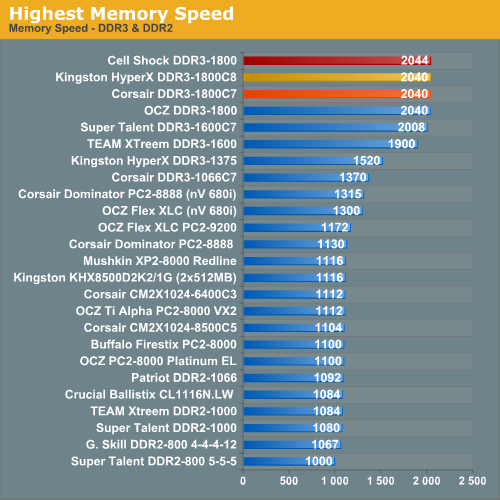
The Kingston DDR3-1800C8 and the Corsair DDR3-1800C7 both top out at DDR3-2040, matching the OCZ DDR3-1800 as the fastest memory tested. Cell Shock 1800 manages one higher FSB with complete stability, with an overclock speed of DDR3-2044. These are all incredible overclocks, with all five memories based on Micron Z9 memory chips exceeding 2000 MHz at the top.
Advances in memory technology are rarely as dramatic as the speed and timing improvements we are seeing with Micron Z9 memory chips. For reference we included our ongoing overclocking chart results for DDR2 just so you can see how significant the new Micron Z9 memory really is. The highest DDR2 we have ever tested reaches DDR2-1315 in an EVGA 680i motherboard. The same memory tops out just above 1100 in our standard DDR2 test bed.
Early DDR3-1066 reached a bit higher than DDR2 such as the typical 1370 achieved with the launch of Corsair DDR3-1066. Timings, however, were somewhat slow. Then the Kingston HyperX pushed 7-7-7 timings all the way to DDR3-1500. Now, just a few months later state-of-the-art DDR3 is reaching DDR3-2000+ at aggressive timings. This kind of progress in memory technology makes the original JEDEC target of 800 to 1600 MHz for DDR3 speeds now appear far too limited.
Even more significant, every new memory tested in this roundup reaches at least DDR3-1950 at fast 7-7-7 timings. The Corsair DDR3-1800 C7 performs best in this test, reaching a stable DDR3-1972 at 7-7-7-18 at 2.15V. This speed far exceeds the specified DDR3-1800 at 7-7-7-21 timings.
Super Pi
In Kingston Launches Low-Latency DDR3 memory performance was compared at 800, 1066, 1333, and highest memory speed. With the introduction of higher speed DDR3 we have added 1600 and 2000 to the standard comparison speeds, if the DDR3 memory is capable of reaching that speed.
To look at pure number crunching, Super Pi 1.5 was run in all memory test configurations. Super Pi is a very simple program as it merely calculates the value of Pi to a designated number of decimal positions. In this case we chose 2 Million places.
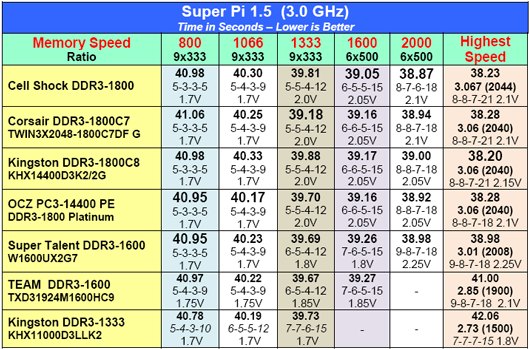 |
| Click chart to enlarge |
Super Pi is fastest (lower value for calc time) on the Kingston DDR3-1800C8, while at 1600 and 2000 the Cell Shock DDR3-1800 is the best performer. Corsair is best at 1333 and OCZ is tops at 800 and 1066. The differences among the five Micron-based memories are extremely small with no clear winner. All the boards are exceptional in their performance.
It is interesting that by 1333 the lower latency DDR3 has completely closed any gap that exists with the fastest timing DDR2, which can run as fast as 3-3-3 timings. Lower latency DDR3 clearly demonstrates you will not have to give up a thing with DDR3 in the overlap speeds and you will gain even more performance at higher speeds as well. The only current roadblock to DDR3 is the high price of admission.
Bandwidth and Memory Scaling
As you saw in the overclocking graph on the previous page, all five of the memories based on Micron Z9 memory chips reached a stable overclock of more than 2000MHz. This remarkable overclock should translate into higher bandwidth with DDR3 at higher speeds.
To better understand memory performance at speeds from DDR3-800 to DDR3-2000+ we compared Standard or Buffered bandwidth of the Cell Shock DDR3-1800, Corsair DDR3-2800C7, and Kingston DDR3-1800C7 at all tested speeds. The processor in each case is running 3.0 GHz as detailed in the Memory Test Configuration on page three. The bandwidths of the three new memories tested in this review were then compared to all DDR3 memory we have tested to date.
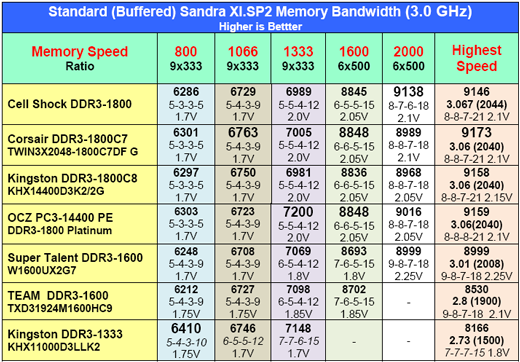 |
| Click chart to enlarge |
At DDR3-800 the Elpida LL based Kingston is the best performer in the standard Sandra bandwidth test. However, at 1066 the lead now shifts to the Corsair 1800, OCZ DDR3-1800 at 1300, Corsair at 1600, Cell Shock at 2000, and the Corsair again at the highest speed. The Micron Z9-based memories now own the bandwidth records at 1066 to the highest speed that can be reached, which is 2044MHz. There is no clear winner among the five Micron memories, with a very tight clustering of results across the test results.
We also test memory with buffering schemes like MMX, SSE, SSE2, SSE3, etc, turned off. While these features do provide apparent improved bandwidth, the Unbuffered bandwidth tends to correlate better with real-world application performance. Unbuffered performance does not always follow the same pattern of buffered memory performance.
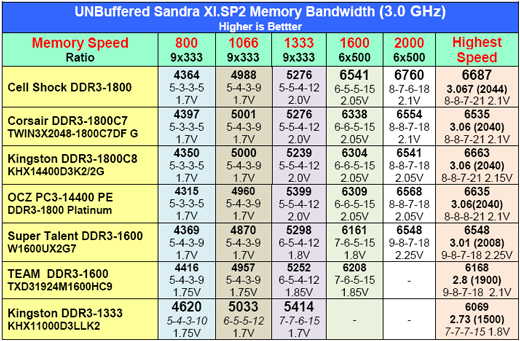 |
| Click chart to enlarge |
The unbuffered results are very interesting, and the memory bandwidth does not really behave the same as the standard buffered test results. There are really two standout memories in this test. The low-latency Elpida-based Kingston DDR3-1333 is top performer at 800, 1066, and 1333. When speed is cranked up to the upper DDR3 speeds, however, the winner is Cell Shock - which tops Unbuffered test results at 1600, 2000, and the highest speed of 2044. Cell Shock appears to have paid careful attention to the types of memory performance that matter most to enthusiasts, which is likely why the new brand has been so well received at enthusiast sites.
This should not be misconstrued, however. Once again the test results from all five Micron based memory kits are very close, and nothing really stood out among this group. The Super Talent was the first Micron Z9 out of the gate, and as such it did not have the benefit of other manufacturers' experiences to help in final binning and programming the SPD. A retest of a more recent Super Talent memory kit will likely show Super Talent has undergone some tweaks with the performance now neck and neck with the other recent Micron entries.
Gaming Performance
Three DX9 games representing different gaming engines are used to test the performance of the Kingston DDR3-1800C8, Corsair DDR3-1800 C7, and Cell Shock DDR3-1800 in real-world gaming. There are certainly more recent gaming titles available, but they are also DX9 and still similar in benchmarking demands as the games tested here. We will update games in the memory test suite as soon as a selection of DX10 games with reliable benchmarks is available. At that time the memory test OS will also be moved to Vista.
The Far Cry - River demo was run for 3 loops and results in FPS were averaged over the 3 runs.
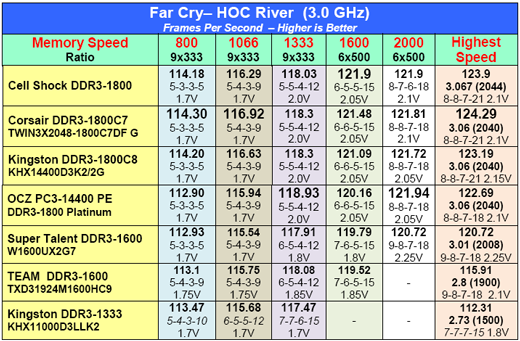 |
| Click chart to enlarge |
Memories with Micron chips now top Far Cry performance at all memory speeds from DDR3-800 to DDR3-2000 and beyond.
Quake 4 and the underlying engine have always proved to be very sensitive to improvements in memory bandwidth. This is amply demonstrated in these memory tests. The performance increases in Quake 4 as DDR3 speed increases are the largest among the tested games.
 |
| Click chart to enlarge |
Kingston, based on Elpida LL memory, performs best at the slower 800 and 1066 speeds, with OCZ and the other Z9 memory topping DDR-1333 to DDR3-2000+. With the constant CPU speed of 3.0GHz we see frame rates improve from 116 to 118 FPS at DDR3-800 5-3-3 to 130 FPS at DDR3-2000 8-8-7, an improvement of just over 12% among the DDR3 test group. We have commented many times that memory is just one small part of the performance equation, but a 12% improvement in a game frame rate merely as the result of an increase in memory speed is significant. Far Cry sees a similar increase from 112.90 at 800 to 124.3 at DDR3-2040, which is about a 10% improvement.
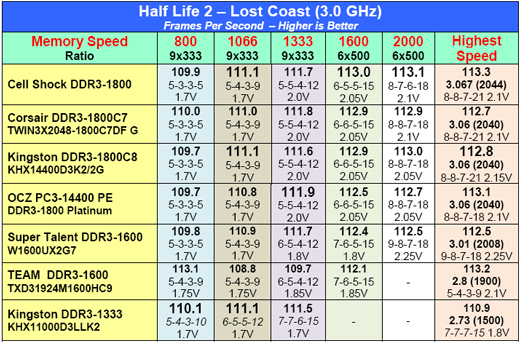 |
| Click chart to enlarge |
We include Half Life 2: Lost Coast as a representative of games that are less sensitive to improvements in memory bandwidth. Lost Coast is played through the Steam engine, where there is the constant worry, for a reviewer, that each new update of Steam will break your test benchmarks. Though the differences are very subtle and HL2 performance is most influenced by the video card used in the benchmark, there are nonetheless patterns that are exactly the same as the other two games.
The Kingston Elpida-based memory wins by a small margin at 800 and ties the Micron-based Cell Shock and Kingston DDR3-1800C8 at the DDR3-1066 speed. Other Micron based memories win the competitions at higher speeds with the Cell Shock the closest to standout performance. All of the results among the Z9 Micron kits are very close.
Some end users consider 7-7-7 timings at high DDR3 speeds a milestone with DDR3. We set those timings and pushed the each of the 3 DDR3-1800 kits as far as possible. The results are very interesting. The OCZ reached DDR3-1900 at 7-7-7 in an earlier review. The three new DDR3-1800 kits all outperformed this result, with Cell Shock reaching DDR3-1952, Kingston reaching DDR3-1960, and Corsair reaching the highest DDR3-1972 - all at 7-7-7- or 7-7-6 timings at 2.1 to 2.15V. We are very close to stable DDR3-2000 at 7-7-7 timings which will further improve DDR3 performance at the top of its speed range.
Conclusion
The recent performance improvements in DDR3 memory have far exceeded anything the end user or industry expected to see in such a short period of time. It is easy to heap praise on DDR3 memory that now routinely reaches DDR3-2000 speed. Put into perspective, the highest official DDR2 speed remains DDR2-800 with the best DDR2 memory performing in the 1100 to1300 range depending on the board and the custom timings that are used.
On the other hand DDR3 launched in July of this year at DDR3-1066 and has quickly ramped up to routine DDR3-2000 performance. Motherboard chipsets and motherboard makers were not completely prepared for a memory speed ramp up of this magnitude. This is evident everywhere with no real 1600 or 2000 ratios available in DDR3 chipsets. You can only achieve such speeds as overclock options.
With the small number of DDR3 kits that we had tested, and that were available for review, it was hard to tell whether these 2000+ speeds were the result of great binning and programming by the likes of OCZ and Super Talent, or whether they were more attributable to the Micron Z9 memory chips themselves. We now have enough test samples to at least begin to answer this question.
With the three additional Micron-based memory kits tested in this review a total of five Z9-based memory kits have been tested at AnandTech. All five reach DDR3-2000 or above as their highest stable memory speed. Today's three kits, all released in a similar time frame, reach 2044/2040/2040 as their highest speed - the same as slightly older OCZ at 2040MHz. Even more amazing is the tight clustering of timings and voltages at every tested memory speed with these 2GB kits. Every kit reaches all but the same timings at the same speed at virtually the same voltage. These results are the most tightly clustered performance results we have ever seen in many years of testing memory.
This can only lead to one of two conclusions. Perhaps all the small to large to specialized memory companies have now reached the same level of expertise in binning, programming SPD, and developing high-performance PCBs for the Micron Z9 chips. We find this possibility extremely unlikely. Or second, the Micron Z9 chips are very uniform as delivered and capable of similar performance. We find this the more likely scenario. This leads to the Micron chips as being the primary push of DDR3 memory to 2000+ speeds.
There is significant expertise in the enthusiast memory market, and that may mean we have not seen the end of higher and higher performing DDR3 modules based on Micron Z9 chips. Other memory makers will also make top performing chips to compete, and some may do it even better than the Micron chips we now have. All of these are good possibilities for the future of DDR3.
However, the best thing that can happen to DDR3 is wide adoption by enthusiasts and significant price drops. There are plenty of reasons to buy DDR3 and it is clearly the fastest memory you can buy today. Unfortunately price is not one of those reasons.
The fact that all of the five Micron-based DDR3-1800 kits perform all but the same in our testing means that you can select any one of these memories based on value and cost. You can also add to that list the new Kingston DDR3-1625 CAS7 (PC3-13000) which performs exactly the same at each speed and overclocks just as high as the slightly more expensive Kingston DDR3-1800C8. This is good news for buyers, but it is not particularly good for memory makers, since they prefer a scenario where real performance differences among memory brands can justify price differences. For now, top DDR3 looks like it will become a price war, but that may change as memory companies try to add more value.
With Micron chips performing so well compared to other DDR3 memory chips, they are naturally demanding a premium in the marketplace. Until another memory manufacturer has something very close in performance to Micron, prices will likely remain high. Another possibility might be a huge manufacturer like Samsung having a lower performance DDR3 chip but buying market share with extremely low pricing. Unfortunately there is little incentive for that event until the DDR3 market grows significantly.
We all know DDR3 memory prices will definitely drop; we just don't know when. However, if the price of admission for DDR3 does not kill the deal for you, DDR3 based on Z9 Micron chips will reward you with standout performance. We have found performance to be so good and so consistent that for now you can really choose a new DDR3 memory kit based on Micron chips just by comparing price, warranty, and other value factors. Performance in our testing has consistently been all but dead even at the top of DDR3.







